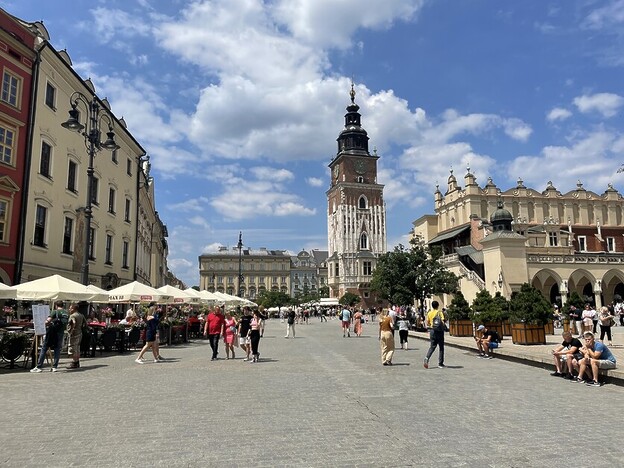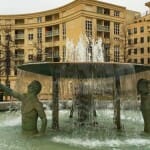In her Guide to Krakow, Anthea Gerrie Visits Poland’s Visitor Favourite, a City Bringing Ghosts Back To Life.
Visitors love Krakow – according to Lonely Planet, the former capital is Poland’s greatest attraction. But that’s down less to geographical attractions like the largest mediaeval market square in Europe than the history, often violent and tragic, which has given the city so many tales to tell over the centuries and led to its cathartic rebirth.
Perhaps surprisingly, it’s not just neighbourhoods which have been reborn, but communities – this city on the doorstep of Auschwitz which lost all but 100 of its 68,000 Jews to the Holocaust now has tenfold that number, and although established by non-Jews missing the klezmer music which also disappeared during World War II with its proponents, Krakow’s Festival of Jewish Culture has become the most celebrated in the world, attracting music lovers of all faiths.

As the largest mediaeval plaza in Europe, Old Town Square tends to be the big draw to Krakow which visitors rush to see first. It’s true this huge space is breathtaking in scale and a buzzy place to people-watch over a drink, perhaps followed by a splurge meal at fine dining establishment Szara Ges. But there’s much more to this ancient Polish capital than the historic centre and beyond it the royal hilltop residence, Wawel Castle, and an excellent tram system brings other must-see districts within easy reach.
Kazimierz, only one tram stop from the centre, offers much more than the nightlife it’s touted for, although it’s true the neighbourhood contains a plethora of bars and restaurants. In fact it’s home to the latest eatery to be recognised by Michelin – Noah, featuring innovative Israeli-inspired cuisine, is one of three establishments in the city to be awarded a Bib Gourmand.
An Israeli influence in the kitchen seems appropriate for a district with ancient Jewish history stretching back to the 16th century, although it is far from the ghetto where an attempt was made to extinguish the entire community during World War II.


Kazimierz was for centuries a harmonious place whose wall separating Jewish and Christian communities came down in 1822, and Jews who moved away to other parts of the city left behind half a dozen magnificent synagogues which survived both Nazi and Communist rule. The youngest, the magnificent Tempel, has metamorphosed into a prime concert venue for the annual Festival of Jewish Culture inaugurated 34 years ago. The festival, which runs the last week of June, dates back to the 90s, and reflects an interest in the revival of Polish culture in general after the country regained its independence.
Not only klezmer and jazz stars but singer-songwriters and performers of every type of music from the classical to the avant-garde come from all over the world to play to a global audience of music-lovers, both in formal venues and a festival tent open to all. There are lectures, film screenings, classes in the Ashkenazi cuisine which has prevailed in Poland for centuries and not to be missed walking tours, including a look into the half-dozen ancient synagogues dotted around Kazimierz.
Restaurants set in lovely gardens offer late dinners and nightcaps to bring a lively post-concert end to the night, and before the show there is nowhere better to grab high-quality dishes like the world’s best chilled beetroot soup than Noah’s sister restaurant, the Bazaar Bistro on Plac Nowy.
Nearby the Golden Tulip, a reliable presence in a neighbourhood surprisingly short on hotels, occupies a prime location within a 5-minute stroll of the festival tent via lively Josefa Street, with its many vintage shops and cool cafes, bars and restaurants, and just two minutes from a tram stop on the main thoroughfare to the old town.


Trams on both sides of Kazimierz offer easy access to the 20th century ghetto established in Podgórze on the far side of the river to be closer to the station from which occupants were so efficiently shipped to the death camps by the Nazis. A moving memorial marks out the ghetto boundary with empty chairs around a deserted square, and its story is told inside the Schindler factory where the eponymous businessman saved 1200 Jewish employees by adding them to his famous List immortalised on film by Steven Spielberg.
As claustrophobic as is this museum telling the harrowing story of those crammed into the ghetto who did not survive is the spacious, bright and optimistic modern building opposite housing MOCAK, Krakow’s Museum of Contemporary Art. Remembrance is never far away even here, where Polish artists attempt to exorcise their own 20th century ghosts, but it’s an inspiring and often uplifting place to visit – allow a full day if planning to explore both museums.


While visiting the death camp of Auschwitz-Birkenau is the most popular excursion from Krakow it’s not the only major landmark on the city’s doorstep. Much easier to take and positively uplifting is the Wieliczka salt mine half an hour from the city centre which won Krakow its second UNESCO World Heritage site designation(the first is Old Town Square).
Visitors descend thousands of feet – lifts are available by arrangement to mitigate the ascent and part of the descent for those who need them – to see astonishing sculptures created by untrained artists, including the great set piece of a huge church complete with altar, chandeliers and religious reliefs which the miners built as a place to pray for their own safety. Advance booking essential, as capacity is limited.
Tell Me More About This Guide to Krakow
Krakow is served from London by British Airways, Ryanair and Wizz Air. More information about this Guide to Krakow can be found at Polska and Krakow.travel with festival information at Jewish Festivals
Where to Stay in Krakow. The The Golden Tulip and new Radisson Red






